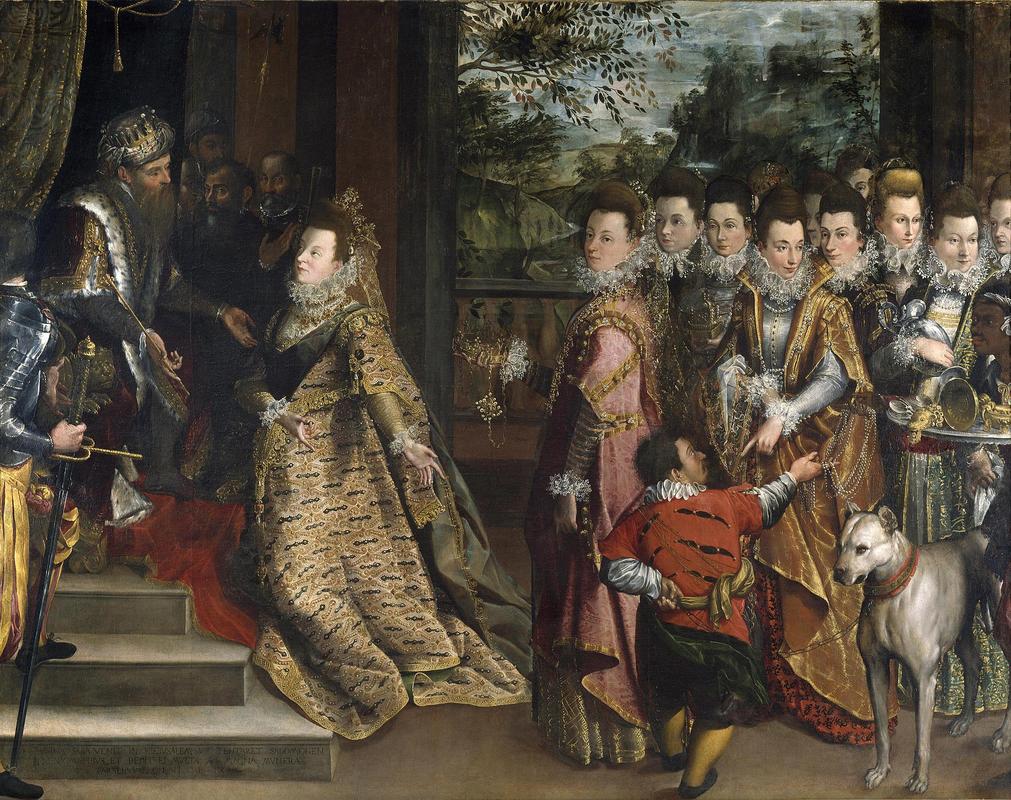More about The Visit of the Queen of Sheba to King Solomon

Contributor
Lavinia Fontana paints The Visit of the Queen of Sheba to King Solomon with a disappointing wealth of Renaissance flair.
We get it, she wanted to make the story more relatable. The costumes of the day were admittedly snazzy (if scratchy collars are your thing) and Fontana wanted to stick with the trends. After all, Alessandro Allori’s stiff-collared portraits gained him some elite funeral and wedding gigs. But did Lavinia have to alter the Queen of Sheba’s visit this heavily? Where are the precious stones Sheba brought for Solomon? The piles of spices? Where are the camels?
Fontana’s depiction knocked out two birds with one stone— bible stories and elite customers. In the roles of the Queen of Sheba and King Solomon are Eleonora de’ Medici and her husband Vincenzo I Gonzaga.
The marriage pictured here is perhaps most iconic because of its vulgar, twisted beginnings. Nowadays, the Medici aren’t quite the nefarious powerhouse they used to be (although one did protest Kimye’s Florence wedding, so you never know). In the 1500s, the Medici were at full strength. But don’t think that housing Michelangelo and Botticelli excuses them for the familial murders. What happens when the notorious Medici family desires a match with a future duke? It depends— is the man in question willing to prove his virility?
In the most horrendous marriage negotiation of the Renaissance, the Medici set out to verify Vincenzo I Gonzaga’s potency. Naturally, he’d had his penis measurements taken, but the family wasn’t inclined to hand over Eleonora so easily. The solution? Gonzaga would violate a virgin in the presence of a Medici agent. Vincenzo disappointed his audience from the start; he wasn’t of adequate size and backed out with a “stomachache” when tested. Eventually, he was deemed capable— but only after the agent checked his erection by hand. Apparently, the ordeal didn’t do much for Gonzaga’s confidence; years later, he directed an apothecary to search Europe and the Americas for some legendary Renaissance Viagra.
Sources
- “Alessandro Allori.” Virtual Uffizi Gallery. Accessed June 17, 2017. https://www.virtualuffizi.com/alessandro-allori.html.
- Finucci, Valeria. "“There's the Rub”: Searching for Sexual Remedies in the New World." Journal of Medieval and Early Modern Studies 38, no. 3 (2008). Accessed June 17, 2017. doi:10.1215/10829636-2008-006.
- Kington, Tom. “Kim Kardashian and Kanye West's Florence wedding angers Medici descendant.” May 24, 2014. Accessed June 17, 2017. http://www.telegraph.co.uk/news/worldnews/europe/italy/10853656/Kim-Kar…
- “Lavinia Fontana Facts.” YourDictionary. Accessed June 17, 2017. http://biography.yourdictionary.com/lavinia-fontana.
- “Murder Among Medicis.” Newsweek. January 9, 2007. Accessed June 17, 2017. http://www.newsweek.com/murder-among-medicis-98491.
- Nix, Elizabeth. “7 Things You May Not Know About the Medicis.” History Lists. November 16, 2016. http://www.history.com/news/history-lists/7-things-you-may-not-know-abo….
- “Queen of Sheba.” Wikipedia. June 13, 2017. https://en.wikipedia.org/wiki/Queen_of_Sheba.
- Terpstra, Nicholas. Lost Girls: Sex and Death in Renaissance Florence. Baltimore: John Hopkins University Press, 2010. Accessed June 17, 2017. https://books.google.com/books?id=gV6W8z4ojSoC&lpg=PP1&dq=Lost%20Girls%…
- ”The visit of the Queen of Sheba to King Solomon by Lavinia Fontana.” National Gallery of Ireland. Accessed June 17, 2017. https://www.nationalgallery.ie/visit-queen-sheba-king-solomon-lavinia-f….











